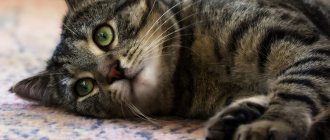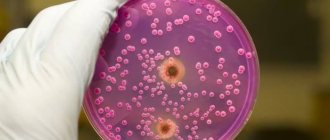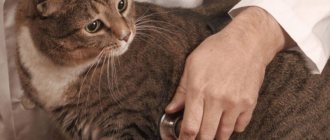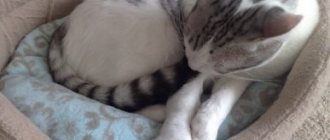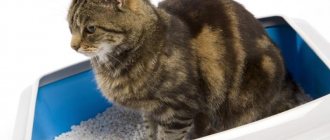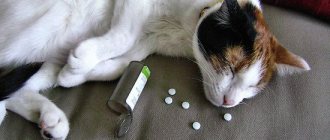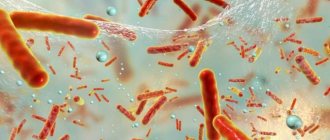Unfortunately, it is not uncommon for a cat to foam at the mouth. At this difficult moment, the owner usually does not know what to do, but he must not be confused and provide first aid to the pet. Another important point is an urgent clarification of the cause of this phenomenon, since it can be a symptom of either banal stress or a serious illness. In any case, the cat should be taken to the veterinarian immediately.
Cats foam at the mouth. Reasons causing hypersalivation:
- infections (calicivirus, herpesvirus, rabies and others);
- stomatitis (inflammatory disease of the oral mucosa);
- gingivitis (inflammation of the gums);
- trauma to the mouth or tongue;
- caustic/caustic toxins (such as household cleaners and some indoor or outdoor plants);
- erosions and ulcers on the tongue and in the oral cavity;
- foreign bodies or tumors in the mouth and esophagus;
- neurological disorder of chewing or swallowing (paresis of the pharyngeal muscles due to botulism, etc.);
- nausea;
- certain metabolic disorders : hepatoencephalopathy - a disorder of the nervous system due to liver dysfunction;
- hyperthermia - increased temperature;
- uremia - the effect of toxins on the body due to impaired kidney function;
In what cases is the help of a veterinarian needed?
Consultation with a veterinarian is required in the following situations:
- lethargy, apathy, sleep disturbance, lack of response to external stimuli, decreased motor activity;
- partial or complete loss of interest in food;
- indigestion (vomiting, diarrhea or constipation);
- foul odor and the appearance of ulcers in the mouth;
- foreign inclusions in foamy vomit (blood, bile, mucus);
- weight loss;
- signs of body dehydration (dehydration);
- rhinitis;
- photophobia;
- increased body temperature;
- epileptic seizures;
- muscle cramps, paralysis;
- greenish vomit;
- discharge from the eyes and nasal passages;
- icteric staining of the mucous membranes;
- incoordination of movements.
When a cat starts foaming at the mouth, owners first of all associate this with the presence of some serious health problems or even rabies. But sometimes this opinion may be wrong. There are a number of physiological reasons why foaming around the mouth may appear. Therefore, before sounding the alarm, the kitten needs to be shown to a doctor to establish an accurate diagnosis and prescribe timely treatment.
Diagnosis of ptyalism in cats
As we've learned, there are many different causes of excessive salivation. Therefore, when visiting a veterinary clinic, be sure to give the doctor your pet's complete medical history to help identify potential causes. You should provide details about your cat's health, vaccinations, any medications (such as anthelmintics), possible exposure to toxins, and whether your cat has eaten any objects. You also need to describe the symptoms in detail.
After collecting anamnesis, the doctor conducts a thorough examination. Some patients sometimes require sedation (putting them into a state of light sleep without anesthesia).
Additional studies may include:
PCR diagnostics to confirm/exclude viral infection;
X-ray of the oral cavity to exclude dental problems and check for the presence of foreign objects in the digestive tract (only high-density radiopaque areas are detected);
Chest and abdominal radiographs to evaluate structures in the chest and abdomen;
Contrast radiography of the esophagus to identify/exclude a foreign body;
Complete blood test to assess immune status. It also helps determine the presence or absence of anemia (low levels of red blood cells in the blood);
Biochemical blood test (general profile and additional indicators) to assess kidney and liver function;
Urinalysis to assess kidney function.
Poisoning
No matter how the owner monitors his pet’s diet, the cat can still swallow any toxic substance. Also, poisoning may not be of a food nature and, for example, occurs due to the absorption into the skin of poisons intended to eliminate fleas.
Common signs of poisoning are:
- Diarrhea;
- unsteady gait (swaying from side to side);
- frequent foamy vomiting.
Advice! Gastric lavage will help alleviate this condition of the animal. They can do it in any veterinary clinic under the strict supervision of doctors.
Treatment of drooling in cats depending on the cause
Based on the problem that causes ptyalism, there are various treatment methods.
Poisoning
In most cases, if a toxic substance is ingested, it is necessary to induce vomiting.
But there are situations when it is strictly forbidden to induce vomiting (for example, in case of poisoning with caustic substances and petroleum products).
Veterinarians also perform gastric lavage with large amounts of water using a special tube-probe, which is passed through the esophagus to the stomach. To neutralize the poison in the stomach, the animal is washed with crushed activated carbon, and the sorbent is also given simply in crushed form, mixed with water. The introduction of antidotes - substances that neutralize poisons - is possible only if it is known exactly what caused the poisoning. Also, in case of poisoning, infusion therapy in a hospital setting is required to more quickly remove toxins from the body and the use of symptomatic medications.
Dental problems
If your cat is foaming at the mouth due to dental or oral disease, it may be due to abscesses. In this case, dental surgery will be needed. Single or multiple tooth extractions may also be required. Any wounds must be cleaned and an antibiotic may be prescribed to clear up the infection.
Neoplasms
If neoplasms are detected, you need to see an oncologist, and then, together with your doctor, decide on further treatment tactics. Surgical removal may be needed or chemotherapy, which can be used to target tumors at the microscopic level.
Kidney or liver diseases
In case of organ failure, it is necessary to conduct a full examination of the pet and prescribe treatment to reduce intoxication in the body.
Infusion therapy in a hospital setting under the supervision of physicians is often required. Sometimes a special diet is necessary. In this case, the veterinarian recommends a medicinal line of food.
Presence of a foreign body
To remove a foreign object that causes salivation, sedation is most often used, that is, the animal is put into a state of sleep. In some cases, endoscopic or abdominal surgery may be required.
Side effects of veterinary drugs
Some veterinary medications, such as anthelmintics, hepatoprotectors or hormonal agents, can cause increased salivation in some animals. As a rule, this symptom stops spontaneously and the pet does not require additional help. The only exceptions are cases of individual intolerance.
Can vomiting be prevented?
To prevent vomiting you need to:
- periodically treat the cat for worms;
- balance the diet;
- think over the feeding regime;
- undergo a preventive veterinary examination annually and undergo routine vaccinations against infections.
If vomiting is caused by the accumulation of wool in the stomach, then special foods or pastes will help speed up its removal from the digestive tract.
It will not be possible to prevent the ingestion of wool, but you can reduce its entry into the stomach. This can be done with the help of combs, mitten brushes, and furminators.
The cat is drooling from his mouth: what to do at home, prognosis of the course of the disease
Our recommendations apply only to home care after visiting a veterinarian.
Hypersalivation in cats is a dangerous symptom, and you cannot help your pet yourself - it can only worsen the situation.
First of all, be sure to call your doctor and take any measures only on the basis of consultation.
During your visit to the clinic, all necessary treatment, medications, care and feeding regimen will be prescribed by your doctor. It is necessary to strictly follow the instructions and regularly contact the veterinarian.
The prognosis depends greatly on the disease that has been diagnosed.
If your cat is suspected of having rabies, it must be quarantined at the Animal Disease Control Station.
Dental problems are usually solved with surgery and cleaning of the mouth. Your doctor may prescribe special medications for home care.
Recovery from poisoning depends largely on how quickly the poisoning was identified and what substance caused it.
The prognosis for kidney and liver disease is guarded and lifelong treatment is often required.
When diagnosing a malignant tumor, the prognosis depends on the type of tumor.
Wool in the stomach
Cats with short hair are not afraid of this problem, but representatives of long-haired breeds are less lucky in this regard. The fur gets into the cat's stomach during the licking process, irritating not only the stomach, but also the oral cavity. The cat begins to drool uncontrollably or vomit, which lasts for a short time.
After the animal burps hairballs with whitish foamy discharge, its behavior and well-being are completely stabilized without outside help.
Preventing excessive drooling in cats
There are some things you can do to minimize the risk of hypersalivation:
- Vaccinate all animals living in the same area against rabies and the most common infections, regularly deworm them and treat them against ectoparasites.
- Maintain good oral hygiene (brush your teeth, use special foods and products to maintain oral hygiene). For example, toothpastes “Globalvet”, “Veda”, “Klini”, “Beafar”, “8 in 1”.
- Visit veterinary clinics periodically to have your pet examined. The “tail” needs to undergo a preventive examination at least once a year.
- Prevent your cat from having access to caustic or toxic substances and dangerous plants.
- Keep the area where your pet lives clean.
- Remove all small objects, threads, needles, rain, etc. from your pet’s access area
Health to you and your cats!
Preventing foaming in the mouth
You can prevent many health problems due to mouth foaming by being responsible and maintaining a safe home for your cat. Do not frighten or allow others to intentionally frighten or worry your cat. Provide a safe, loving place where your cat feels safe and at home to avoid problems associated with fear and anxiety.
As your cat ages, common dental conditions may become apparent. Annual or semi-annual dental cleanings will help maintain your furry companion's oral health. With a little patience and the right tools, you can also brush your cat's teeth and gums daily to keep her mouth clean between hygiene visits.
Never use human dentifrices, including toothpaste, as they may be toxic if swallowed. Natural cat food with a higher water content will also help prevent plaque and bacteria from forming in your cat's mouth.
If you administer flea and tick medication, make sure it is specifically for cats and follow the instructions. Formulas intended for dogs will have higher concentrations, which may be toxic to your cat. Most topical medications are placed on the neck behind the head where your cat can't ingest it when groomed, but keep altruistic grooming in mind if you have multiple cats or even a dog that you are treating.
When to start sounding the alarm
Vomiting blood in a cat: reasons, what to do
In addition to physiological reasons, there are situations when it is worth acting immediately so as not to aggravate the situation and give the animal a chance for a further healthy life. There are a number of pathological health problems that can cause cats to foam at the mouth.
Epilepsy
This disease is caused by a serious pathology of the brain. To identify epilepsy, you should know what its main symptoms are:
- unnatural arching of the body;
- strong secretion of saliva;
- strange cat behavior;
- the animal's blank gaze and dilated pupils;
- urinary and fecal incontinence;
- frequent and heavy breathing.
Epilepsy in a cat
Epileptic seizures in cats can occur with different frequency: in some - once a week, and in others - 1-2 times a year.
Attention! Sometimes the foamy growths may turn pink, a sign that the tongue or the outer part of the cheeks was bitten during the seizure.
Poisoning
The appearance of foamy formations can be caused by poisoning of the cat, for example, household chemicals, flower poisons, poor-quality food, or something else. Symptoms of poisoning are as follows:
- diarrhea;
- nausea and vomiting;
- complete apathy or, on the contrary, irritation;
- dilation of the pupils is observed;
- body temperature below 38 degrees;
- tachycardia;
- unsteady gait.
Plague
The scientific name of the disease is “panleukopenia”, and in common parlance it is feline distemper.
To recognize this disease, you should pay attention to the following symptoms:
- high body temperature, reaching 41-42 degrees;
- vomiting with foam, mucus or blood;
- urine becomes darker;
- one or both eyes water and purulent discharge occurs;
- the cat completely refuses water;
- frequent and intermittent breathing;
- The cat looks for a distant corner in the house, where it then lies for a long time.
For reference: contrary to popular belief, feline distemper is not dangerous to humans. Therefore, the animal owner can and should help the pet.
Infections
Infectious diseases can provoke foamy discharge from the mouth, and the worst among them is rabies.
The disease can be mild or severe. During a mild form, the animal becomes apathetic, afraid of light and refuses any food. In the acute form, there is excessive affection towards the owner, which gradually develops into aggression and attack. Also, the cat may eat inedible objects, the eyes become cloudy, the pupils are dilated, and saliva is released profusely.
Important! Rabies is dangerous to humans. If you have any suspicions, after being bitten by a cat with symptoms of the disease, you should immediately go to the hospital for qualified help. Once the virus has penetrated the nerve fibers, the process becomes irreversible.
Today there is no cure for rabies and therefore this disease ends in the death of the animal.
Gastrointestinal diseases
Foam formations can occur in the presence of gastritis, pancreatitis, enteritis, ulcers and other problems. Each of the diseases has its own symptoms, but common ones include constipation, diarrhea, flatulence, pain, complete lack of appetite, vomiting with blood, as well as deterioration in the appearance of the animal.
Gastrointestinal problems in animals
Foam after giving medicine: is it necessary to panic?
Inept giving of tablets, drops in the mouth or suspension by the breeder himself in almost 100% of cases provokes foamy, profuse discharge from the mouth. This is explained by the effect of a bitter taste on the taste buds and thus the cat tries to get rid of the medicine that has entered the oral cavity.
The worst that can happen is that the required amount of the drug does not enter the body and the effect will be insignificant or absent. Therefore, if the owner is not confident in his dexterity, it is better to bring the cat to a veterinary clinic or call a doctor at home by phone, around the clock.
When do you urgently need help?
Foaming from the mouth of a cat plus accompanying symptoms indicate severe pathologies in the animal that require immediate attention from a veterinarian. You cannot treat your pet at home on your own; there is a high chance of making a mistake about the cause and aggravating the course of the underlying disease, even leading to death.
When you need to deliver a cat to the RosVet Exhibition Center:
- poisoning (chemicals, rat poison, medications, etc.) is accompanied by copious amounts of foam from the cat’s mouth, coupled with vomiting, diarrhea, dilated pupils, convulsions up to coma;
- epilepsy in cats. Seizures are accompanied by blistering discharge, convulsions, involuntary emptying of the bladder and bowels;
- rabies. Along with foam, fear of water, paralysis of the pharynx and lower jaw, and convulsions appear;
- panleukopenia (plague). Viral infection, occurs with hyperthermia, discharge from the eyes and nose;
- inflammation of the brain (concussion). Foam as a symptom is accompanied by signs: unsteadiness of gait, convulsions.
The formation of foam in a cat provokes severe pain in any location, but especially in the head area. With a severe infestation of worms, vomiting with foam and parasites is a typical sign. In this case, it is prohibited to give anthelmintics yourself; you need to urgently take the cat to the clinic.
Signs of an epileptic seizure
The mechanics of the occurrence of epilepsy has not been precisely clarified at the moment, but it is known that seizures begin against the background of intense stimulation of areas of the cerebral cortex due to increased electrical activity of nerve endings.
Signs of an attack, as a rule, vary from person to person, but there is a certain set of symptoms that helps determine the stage of the attack and immediately proceed to first aid procedures. Such crises cause great pain and stress to the patient, so after the seizure the victim must be handled very carefully.
Signs of an epileptic seizure include:
- sudden loss of balance, falling to the ground;
- loss of consciousness;
- nausea, vomiting;
- heavy breathing;
- muscle hypertonicity;
- inseparable loud shouting;
- a sharp increase in blood pressure;
- blood from the nose;
- involuntary throwing of the head back;
- “glass eyes”;
- increased salivation, sometimes with foam;
- loss of sense of reality of the surrounding world;
- disruption of the thinking process, misunderstanding of words or shouts of strangers;
- involuntary bowel movements or urination;
- local convulsions or convulsions of the whole body;
- numbness of the limbs;
- pupils stop responding to light;
- bluishness or redness of the face and other skin;
- very rapid pulse or its strong decrease;
- convulsions.
It is quite difficult to prevent an attack, but by certain indicators you can understand its approach and take the patient to a safe place.
Expert opinion
Author: Olga Vladimirovna Boyko Neurologist, Doctor of Medical Sciences
Doctors consider epilepsy one of the most dangerous neurological pathologies. This is because a seizure can occur at any time. This increases the risk of injury. Therefore, epilepsy requires timely diagnosis and treatment. The disease occupies a leading place in the structure of disability. According to statistics, 30% of patients are disabled people of group 1 or 2. In order to reduce the risk of injury during an epileptic attack, doctors have developed special first aid recommendations. Anyone can familiarize themselves with them.Doctors at the Yusupov Hospital diagnose and treat various forms of epilepsy. Modern European CT, MRI and EEG equipment are used for examination. This medical equipment allows you to quickly determine the localization of the pathological focus. The quality of treatment depends on the accuracy of the research. An individual therapeutic plan is drawn up by experienced neurologists and epileptologists. If you follow medical recommendations for the treatment and prevention of epileptic seizures, 60-70% of patients at the Yusupov Hospital achieve long-term remission.
Causes of occurrence and development
There are no immediate causes that can cause an epileptic seizure, but there are a number of risk factors that, under certain circumstances, can trigger an epileptic seizure. Risk factors can be either congenital or acquired.
Hereditary predisposition involves the special functioning of neurons and their tendency to spontaneous excitation. This feature can be passed on from generation to generation, but does not always manifest itself. Epilepsy with a hereditary predisposition can develop in the case of acquired provoking factors, namely:
- with cerebral hemorrhage or other cerebrovascular accidents;
- after traumatic brain injury;
- as a result of prolonged alcoholism, use of narcotic and psychotropic drugs, severe stress;
- with meningitis, encephalitis;
- for birth injuries;
- with a brain abscess or stroke;
- in the presence of aneurysms, cysts or adhesions in the brain.
Factors influencing the occurrence of an epileptic seizure are:
- poor sleep patterns;
- drinking alcohol, caffeine, taking any amount of drugs, antidepressants not prescribed by a doctor;
- refusal to take medications or undergo therapy;
- smoking;
- stress;
- changes in hormonal levels due to certain diseases;
- menstruation in women.
It is very important to understand: if an attack has begun, in no case should you give the patient any medications, especially those that are not prescribed by the attending physician. In such a situation, the process has already started, and any pills can only do harm. An attack, if it lasts no more than three minutes, should simply be controlled and not try to bring the person to his senses. However, if the attack lasts longer, it is important to call a medical team.
Doctors at the Yusupov Hospital work around the clock, so in case of complications after epileptic syndrome, you should immediately consult a doctor to avoid disastrous consequences. We will help our patients get out of any difficult situation.
What to do
- If a cat is foaming at the mouth and the owner knows exactly the cause (physiological symptom), no special treatment is required.
- Stop treating your cat with bitter medications and replace them with others.
- To improve the removal of hairballs, it is advisable to purchase a special paste (gel) or give your pet a teaspoon of Vaseline.
- Household chemicals, medicines, poisons, fertilizers, house plants that are dangerous to your pet must be stored out of reach of them. Do not feed your cat human food (onions, chocolate, dough, raisins).
- If a foreign body, pathological changes in the oral cavity, an infectious disease, or head injuries are detected, you must seek help from a veterinarian.
- If the cat starts foaming and has convulsions (epileptic seizure), you need to wait until the cat’s seizure ends, laying it on a flat surface and providing it with rest, then taking it to a veterinary hospital. During transportation, it is necessary to ensure that the cat does not choke. The disease is severe and cannot be treated. You can only alleviate the animal’s condition a little.
- In case of poisoning, it is necessary to induce a gag reflex (a teaspoon of hydrogen peroxide inside or salt on the tongue on the tip of a teaspoon, apomorphine), give a sorbent (activated carbon, sorbex, smecta) and a laxative (Glauber's salt or Epsom salt). Then it is advisable to turn to professionals for help.
- If worms are found in the vomit, be sure to consult with a veterinarian about the selection of an anthelmintic drug (drontal, prazicide, azipirin, praten, febtal).
If foam and saliva are released from the mouth, owners must immediately contact a veterinarian in such cases.:
- The discharge is not one-time, but multiple.
- There are accompanying symptoms (the cat feels sick, has severe vomiting with impurities, convulsions, paralysis, high fever, etc.).
- The general condition of the animal changes for the worse.
